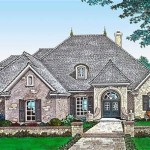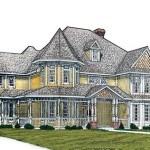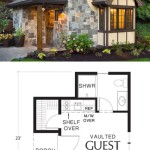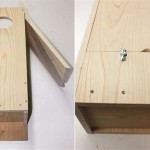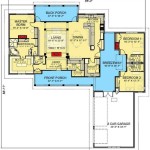Front Sloping Lot House Plans are architectural designs specifically tailored to accommodate the unique challenges of building on a lot with a downward slope from the street. These plans consider the impact of the slope on factors such as drainage, foundation stability, and accessibility. By accounting for the grade of the land, front sloping lot house plans ensure optimal functionality, structural integrity, and curb appeal.
One common example of a front sloping lot is in hillside areas, where the terrain naturally slopes downward. Building a home on such a lot requires careful planning and specialized designs to address the slope’s implications. Architects and builders must incorporate features such as retaining walls, terracing, and drainage systems to mitigate potential issues and enhance the home’s overall safety and livability.
In the following sections, we will delve into the key considerations and benefits of front sloping lot house plans, exploring how they optimize space, enhance aesthetics, and provide practical solutions for challenging building sites.
Front Sloping Lot House Plans offer several important advantages:
- Maximize Space Utilization
- Enhanced Curb Appeal
- Improved Drainage
- Natural Light Optimization
- Privacy and Seclusion
- Unique Architectural Features
- Cost-Effective Solutions
- Stunning Views (if applicable)
These plans provide creative and practical solutions for building on challenging terrain, transforming sloping lots into desirable and functional living spaces.
Maximize Space Utilization
Front Sloping Lot House Plans excel in maximizing space utilization by taking advantage of the natural grade of the land. Here are key ways in which these plans achieve optimal space usage:
- Multi-Level Design: By incorporating multiple levels into the home’s design, sloping lot plans create additional living space without increasing the overall footprint of the house. Split-level or terraced designs allow for the creation of separate living areas, bedrooms, and other functional spaces, maximizing the usable area of the lot.
- Walk-Out Basements: Walk-out basements are a common feature in front sloping lot homes. These basements are partially or fully exposed above ground, providing direct access to the backyard and creating additional living space that can be used for recreation, entertainment, or storage. Walk-out basements effectively utilize the sloping terrain to expand the usable area of the home.
- Sloped Ceilings: Sloped ceilings in rooms that follow the natural grade of the land create a sense of spaciousness and volume. By incorporating vaulted or cathedral ceilings in upper-level rooms, architects can maximize the perceived height and openness of the space, making the home feel larger and more inviting.
- Built-In Storage: Sloping lot homes often incorporate built-in storage solutions to utilize unused spaces and maximize functionality. Under-stair storage, built-in shelving, and attic spaces can be cleverly designed to accommodate belongings and keep the home organized, maximizing usable space without compromising on aesthetics or comfort.
Overall, Front Sloping Lot House Plans offer innovative and practical solutions to maximize space utilization on challenging terrains, creating homes that are both functional and visually appealing.
Enhanced Curb Appeal
Front Sloping Lot House Plans offer unique opportunities to enhance the curb appeal of a home, creating a visually striking and inviting exterior. Here are key ways in which these plans contribute to an enhanced curb appeal:
### Dramatic Architectural DetailsSloping lot homes often incorporate dramatic architectural details that set them apart from traditional designs. Multi-level facades, cascading roofs, and varied textures create a visually interesting and dynamic exterior. The interplay of angles and planes adds depth and character to the home, making it a standout in the neighborhood.### Terraced LandscapingTerraced landscaping is a common feature in front sloping lot homes, creating a visually appealing transition between the house and the street. Retaining walls and tiered gardens add visual interest and dimension to the landscape, enhancing the overall curb appeal. Sloping lawns and walkways create a sense of movement and flow, guiding visitors towards the home’s entrance.### Maximized Outdoor Living SpacesSloping lot homes often feature expanded outdoor living spaces, such as decks, patios, and balconies. These spaces take advantage of the natural grade of the land, offering panoramic views and creating seamless transitions between indoor and outdoor living. Outdoor fireplaces, seating areas, and pergolas further enhance the curb appeal, making the home an inviting destination for relaxation and entertainment.### Unique EntrywaysFront entrances in sloping lot homes are often designed to make a statement. They may feature grand staircases, covered porches, or double-height foyers that create a sense of arrival and welcome guests into the home. The interplay of levels and angles in the entryway adds visual interest and sets the tone for the rest of the house.### Paragraph after details
Overall, Front Sloping Lot House Plans provide ample opportunities to enhance curb appeal and create a visually stunning exterior. By embracing the challenges of the sloping terrain, architects can design homes that are both functional and aesthetically pleasing, making them highly desirable properties in any neighborhood.
Improved Drainage
Front Sloping Lot House Plans prioritize effective drainage solutions to prevent water accumulation and potential damage to the home’s foundation and structure. Here are key ways in which these plans ensure improved drainage:
### Proper Grading and SlopingThe grading and sloping of the lot play a crucial role in directing water away from the home’s foundation. Architects carefully design the slope of the land to ensure that water flows naturally downhill, preventing pooling and seepage. Proper grading also involves creating swales and berms to channel water away from the house and towards designated drainage areas.### French Drains and Subsurface Drainage SystemsFrench drains and subsurface drainage systems are commonly employed in sloping lot homes to collect and redirect excess water. French drains are trenches filled with gravel or perforated pipes that collect water from the surrounding soil and direct it to a designated discharge point. Subsurface drainage systems involve installing perforated pipes underground to collect and drain water away from the foundation.### Gutters and DownspoutsGutters and downspouts are essential for diverting rainwater from the roof and away from the home’s foundation. Front sloping lot homes often incorporate larger gutters and downspouts to handle the increased flow of water during heavy rainfall. These systems are designed to channel water away from the house and direct it to designated drainage areas, such as rain barrels or storm drains.### Dry Wells and Retention PondsIn some cases, dry wells or retention ponds may be incorporated into the drainage plan for sloping lot homes. Dry wells are underground chambers filled with gravel or perforated pipes that collect and store excess water from the surrounding soil. Retention ponds are larger, above-ground basins designed to hold and gradually release stormwater, reducing the risk of flooding.### Paragraph after details
By implementing these comprehensive drainage solutions, Front Sloping Lot House Plans effectively manage water flow, protect the home’s foundation and structure, and ensure a healthy and dry living environment.
Natural Light Optimization
Front Sloping Lot House Plans offer unique opportunities to optimize natural light, creating bright and airy living spaces that enhance the overall well-being of occupants. Here are key ways in which these plans maximize the use of natural light:### Large Windows and SkylightsSloping lot homes often feature expansive windows and skylights strategically placed to capture natural light from multiple angles. Large windows facing south or west allow for maximum sunlight to enter the home during the day, reducing the need for artificial lighting. Skylights in the roof or upper-level rooms bring in natural light from above, illuminating interior spaces and creating a sense of openness.### Open Floor Plans and Vaulted CeilingsOpen floor plans and vaulted ceilings contribute to natural light optimization in sloping lot homes. By minimizing walls and obstructions, open floor plans allow light to flow freely throughout the living spaces. Vaulted ceilings create a sense of height and spaciousness, allowing for more windows and skylights to be incorporated into the design.### Light-Colored Interiors and Reflective SurfacesFront sloping lot house plans often incorporate light-colored interiors and reflective surfaces to enhance the distribution and reflection of natural light. Light-colored walls, ceilings, and flooring reflect and bounce light, making the spaces feel brighter and more inviting. Reflective surfaces, such as mirrors and polished tiles, further amplify the available natural light, creating a more vibrant and welcoming atmosphere.### Paragraph after detailsBy embracing these natural light optimization strategies, Front Sloping Lot House Plans create homes that are filled with natural light, reducing energy consumption, improving mood and productivity, and enhancing the overall quality of life for occupants.
Privacy and Seclusion
Front Sloping Lot House Plans offer unique opportunities to enhance privacy and seclusion, creating a sense of tranquility and refuge within the home. Here are key ways in which these plans achieve optimal privacy and seclusion:
### Elevated PositionSloping lot homes are often built on elevated positions, providing a natural buffer from the street and neighboring properties. This elevation creates a sense of privacy and seclusion, as the home is less visible from below and offers panoramic views of the surrounding landscape.### Natural BarriersSloping lot homes can take advantage of natural barriers, such as trees, shrubs, and rock formations, to enhance privacy and seclusion. These barriers can be incorporated into the landscape design to create private outdoor spaces, such as screened patios or secluded gardens, that are shielded from view.### Strategic Window PlacementArchitects carefully consider window placement in sloping lot homes to maximize natural light while maintaining privacy. Windows are often positioned to offer views of the surrounding landscape without compromising the privacy of the occupants. Frosted glass, curtains, and blinds can be used to further enhance privacy in specific areas of the home.### Setbacks from Property LinesFront sloping lot house plans often incorporate setbacks from property lines to create a buffer zone between the home and neighboring properties. This buffer zone provides additional privacy and reduces noise and visual disturbances from adjacent homes.### Paragraph after details
By implementing these strategies, Front Sloping Lot House Plans create homes that offer a high level of privacy and seclusion, allowing occupants to enjoy their living spaces in peace and tranquility.
Unique Architectural Features
Front Sloping Lot House Plans often incorporate unique architectural features that take advantage of the sloping terrain and create visually striking homes. These features not only enhance the aesthetic appeal of the house but also provide functional benefits.
- Multi-Level Designs: Sloping lot homes often feature multi-level designs that create interesting and dynamic floor plans. Split-level homes, for example, have different living areas located at different levels, connected by stairs. This design allows for better space utilization and can create a sense of separation between different areas of the home.
- Walk-Out Basements: Walk-out basements are a common feature in sloping lot homes. These basements have direct access to the backyard, providing additional living space and natural light. Walk-out basements can be used for a variety of purposes, such as recreation rooms, home offices, or guest suites.
- Terraced Landscaping: Terraced landscaping is a popular choice for sloping lot homes. This involves creating a series of level terraces on the slope, which can be used for gardening, seating areas, or other outdoor activities. Terraced landscaping not only enhances the visual appeal of the home but also helps to prevent soil erosion and improve drainage.
- Unique Rooflines: Sloping lot homes often have unique rooflines that are designed to complement the slope of the land. These rooflines can be complex and visually interesting, adding character to the home. Some common rooflines for sloping lot homes include gable roofs, hip roofs, and shed roofs.
These are just a few of the unique architectural features that can be found in Front Sloping Lot House Plans. By embracing the challenges of the sloping terrain, architects can create homes that are both functional and visually stunning.
Cost-Effective Solutions
### Maximizing Space UtilizationOne of the key ways to reduce costs in Front Sloping Lot House Plans is to maximize space utilization. This can be achieved through careful planning and design, such as incorporating multi-level designs, walk-out basements, and built-in storage solutions. Multi-level designs allow for more living space without increasing the overall footprint of the house, while walk-out basements provide additional living space at a lower cost than above-ground construction. Built-in storage solutions, such as under-stair storage and attic spaces, can help to reduce the need for additional furniture and storage units, further saving on costs.### Efficient Use of MaterialsAnother cost-effective strategy is to use materials efficiently. This involves choosing materials that are both durable and cost-effective, and using them in a way that minimizes waste. For example, using pre-fabricated components, such as roof trusses and wall panels, can save time and labor costs during construction. Additionally, using sustainable materials, such as recycled or reclaimed materials, can also help to reduce costs while promoting environmental responsibility.### Smart Drainage SolutionsEffective drainage solutions are essential for sloping lot homes, but they can also be costly to implement. To reduce costs, consider using natural drainage solutions, such as swales and berms, to direct water away from the home. These solutions are typically less expensive than installing underground drainage systems, and they can also help to improve the overall landscape design. Additionally, consider using rain barrels to collect rainwater for irrigation or other non-potable uses, reducing the demand for municipal water and potentially lowering water bills.### Energy-Efficient FeaturesIncorporating energy-efficient features into the design of a sloping lot home can help to reduce long-term operating costs. This can include installing energy-efficient windows and appliances, as well as using passive solar design principles to maximize natural heating and cooling. By reducing energy consumption, homeowners can save money on their utility bills and contribute to a more sustainable lifestyle.Overall, Front Sloping Lot House Plans offer a variety of cost-effective solutions to suit different budgets and needs. By carefully considering space utilization, material selection, drainage solutions, and energy efficiency, homeowners can build beautiful and functional homes on sloping lots without breaking the bank.
Stunning Views (if applicable)
Front Sloping Lot House Plans often offer the potential for stunning views, depending on the specific location and orientation of the lot. By taking advantage of the elevated position and natural contours of the land, these homes can provide panoramic vistas of surrounding landscapes, city skylines, or water bodies.
- Unobstructed Views: Sloping lots often provide unobstructed views due to their elevated position. This can be especially valuable in areas with scenic surroundings, such as mountains, forests, or waterfronts. Large windows and decks or balconies can be incorporated into the design to maximize the enjoyment of these views.
- Expansive Vistas: The sloping terrain of these lots allows for expansive vistas that stretch far into the distance. This can create a sense of openness and grandeur, making the home feel more connected to the surrounding environment.
- Privacy and Seclusion: Sloping lots can offer a sense of privacy and seclusion, as they are often positioned above or below neighboring properties. This can be particularly beneficial for homes that are seeking to take advantage of views without sacrificing privacy.
- Natural Light and Sun Exposure: The orientation of sloping lots can provide optimal natural light and sun exposure. By carefully positioning the home on the lot, architects can design spaces that are flooded with natural light while also providing shade and protection from the elements.
Overall, Front Sloping Lot House Plans can offer the potential for truly stunning views, creating homes that are not only visually appealing but also provide a unique and immersive connection to the surrounding environment.










Related Posts

